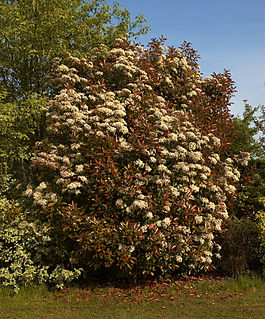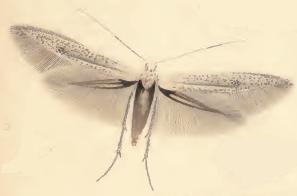
Pyracantha is a genus of large, thorny evergreen shrubs in the family Rosaceae, with common names firethorn or pyracantha. They are native to an area extending from Southwest Europe east to Southeast Asia. They resemble and are related to Cotoneaster, but have serrated leaf margins and numerous thorns.

Cotoneaster is a genus of flowering plants in the rose family, Rosaceae, native to the Palaearctic region, with a strong concentration of diversity in the genus in the mountains of southwestern China and the Himalayas. They are related to hawthorns (Crataegus), firethorns (Pyracantha), photinias (Photinia), and rowans (Sorbus).

Photinia is a genus of about 40–60 species of small trees and large shrubs, but the taxonomy has recently varied greatly, with the genera Heteromeles, Stranvaesia and Aronia sometimes included in Photinia.

Cotoneaster franchetii is a species of Cotoneaster native to southwestern China, in the provinces of Guizhou, Sichuan, Tibet, and Yunnan, and also in adjacent northern Myanmar and northern Thailand.

Cotoneaster cambricus is a species of Cotoneaster endemic to the Great Orme peninsula in north Wales. It is the only species of Cotoneaster native to the British Isles. It has never been found naturally at any other location. In the past, it was included within the widespread eastern European Cotoneaster integerrimus, but differs from that in genetic profile.

Cotoneaster integerrimus, the common cotoneaster, is a species of Cotoneaster native to central and eastern Europe and southwest Asia, from southern Belgium and eastern France south to Italy, and east through Germany to the Balkans, northern Turkey, the Crimea, the Caucasus and northern Iran; plants in Spain may also belong in this species. In the past, it was treated in a wider sense, including plants from Wales now split off as Cotoneaster cambricus and plants from Scandinavia now treated as Cotoneaster scandinavicus, but differs from these in genetic profile and detail of foliage and fruit.

Cotoneaster pannosus is a species of Cotoneaster known by the common name silverleaf cotoneaster. This woody shrub is native to south central China but it has been introduced to other areas of the world, including southern Africa and Australia as an ornamental. It has become naturalized in some areas but it is a troublesome noxious weed in others, for example, in Hawaii. This is a sprawling shrub easily reaching over 3 meters in height. It is covered in dull green oval-shaped leaves with fuzzy white undersides and blooms in white flowers. The fruits are red-orange pomes containing two seeds each. These fruits are very attractive to birds, which are the main agent of seed dispersal. It grows on the elevation of 3,280 feet (1,000 m).

Stigmella oxyacanthella is a moth of the family Nepticulidae. It is found from Fennoscandia to the Pyrenees, Italy and Bulgaria, and from Ireland to central Russia.

Stigmella magdalenae is a moth of the family Nepticulidae. It is found from Scandinavia and Finland to the Pyrenees, Italy and Bulgaria, and from Ireland to central Russia and Ukraine.

The pear leaf blister moth, ribbed apple leaf miner or apple leaf miner is a moth of the Lyonetiidae family that can be found in all of Europe.

Sclerocroton integerrimus, the duiker berry, is a tree in the family Euphorbiaceae, from Southern Africa.

Lyonetia prunifoliella is a moth in the family Lyonetiidae.
Phyllonorycter deschkai is a moth of the family Gracillariidae. It is known from Alps on altitudes between 500 and 1,750 meters.

Phyllonorycter mespilella is a moth of the family Gracillariidae. It is found from Germany to the Iberian Peninsula, Sardinia, Italy and the Carpathian Mountains and from Ireland to southern Russia. It also occurs over much of western North America, from California north to British Columbia, and east to Utah and New Mexico.

Phyllonorycter sorbi is a moth of the family Gracillariidae. It is known from all of Europe, except the Balkan Peninsula.
Callisto pfaffenzelleri is a moth of the family Gracillariidae. It is known from the Alps and Slovenia.

The fruit tree case moth is a moth of the family Coleophoridae, found in western Europe.

Râpa Roșie is a protected area, a natural monument of national interest in Alba County, Romania. It is a geological and botanical reserve, located in the extreme southwest of the Secaşelor Plateau on the right bank of the Secașul Mare, about 4 kilometres (2.5 mi) north of Sebeș. With a size of approximately 24 hectares, the reserve is classified as IUCN Category III. Erosion and runoff has given it a prominent, sharp rocky appearance in the mountainside. Râpa Roșie itself measures approximately 10 hectares in size. Râpa Roșie stretches over a length of 800 metres (2,600 ft). Its height measures between 50–125 metres (164–410 ft). A huge wall, almost vertical, gives the impression of a ruined ancestral monument. Tiered columns and pyramids, separated by ravines, form a badlands microrelief. The first report of a Coţofeni culture find at Râpa Roşie was made by Fr. W. Schuster in 1865. It was the first archaeological exploration made by him which revealed remnants of large and small pottery that had ornamentation, which also attested to the Coţofeni culture.
Athrips medjella is a moth of the family Gelechiidae. It is found in southern France.

Corokia cotoneaster is a flowering plant in the family Argophyllaceae. Which was described by Étienne Fiacre Louis Raoul in 1846. Usually, this plant is known by the name wire-netting bush, korokio / korokia-tarango. The word "Koriko" comes from the Māori language.















